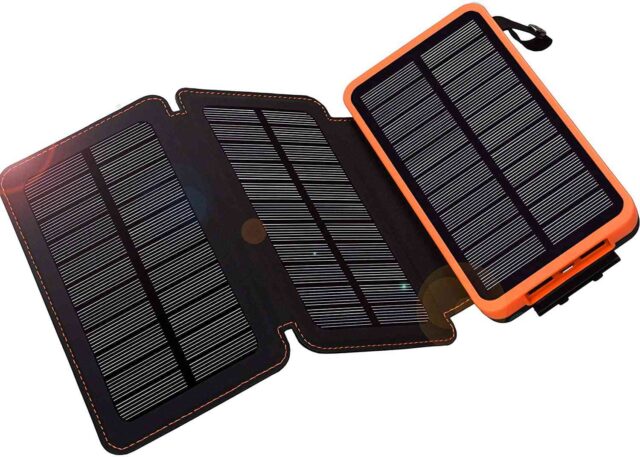In a sea of cheap, low-quality solar chargers, it’s hard to find an attractive, durable, and reliable one. The best portable solar chargers are designed to look good and last, and they come in many shapes and sizes to suit your needs.
We all know that, when it comes to getting a charge out of the Sun, there’s no better way to do than via a portable solar charger. And, if you don’t believe us, just do a search of the term “solar charger” on Amazon.com and see all the products that customers have purchased. But, there’s a lot of confusion out there, when it comes to choosing the right portable solar charger for you. So, we want to help you, by taking you through our top picks for the best portable solar chargers on the market.
Luke Cuenco 05.28.21  Modern problems have modern solutions. I know many of us are trying to get away from home and the city and leave all our technology behind. But despite all our efforts, technology always seems to follow us wherever we go. On the other hand, many of the technologies we carry can be incredibly useful, providing an extra level of safety and comfort on long treks through the wilderness, or just keeping the music on during a day at the lake.
Modern problems have modern solutions. I know many of us are trying to get away from home and the city and leave all our technology behind. But despite all our efforts, technology always seems to follow us wherever we go. On the other hand, many of the technologies we carry can be incredibly useful, providing an extra level of safety and comfort on long treks through the wilderness, or just keeping the music on during a day at the lake.
Solar chargers are one of the best ways to keep your devices charged and ready to use in the great outdoors when traditional power sources are not available. The best portable solar chargers on the market may shock you…. But at least you have enough to work with. All kidding aside, a way to charge your devices wherever you are is something to take seriously when planning an adventure. + – Table of contents
1. BioLite SolarPanel 5+ – Editor’s Choice
 Probably one of the most comprehensive options on the market, the BioLite SolarPanel 5+ does two things for you. Not only can you harness solar power with the SolarPanel 5+, but it also has a built-in energy storage of up to 2,200 mAh (about half the capacity of the Samsung Galaxy S20 Ultra). So you can charge your mobile phone, GPS or satellite phone without worrying about not having a ready-made power source. The maximum output of the battery is 5 watts (5 volts at 1 ampere). The SolarPanel 5+ has a built-in solar clock that helps you optimize the panel for efficient charging.
Probably one of the most comprehensive options on the market, the BioLite SolarPanel 5+ does two things for you. Not only can you harness solar power with the SolarPanel 5+, but it also has a built-in energy storage of up to 2,200 mAh (about half the capacity of the Samsung Galaxy S20 Ultra). So you can charge your mobile phone, GPS or satellite phone without worrying about not having a ready-made power source. The maximum output of the battery is 5 watts (5 volts at 1 ampere). The SolarPanel 5+ has a built-in solar clock that helps you optimize the panel for efficient charging.
The built-in 360-degree stand is also handy, as it allows you to set the panel on an uneven surface and keep it charged while you set up camp or prepare breakfast. Most importantly, it has a USB input and output. This means you can charge the SolarPanel 5+ at home or in the car on your way to your next adventure and leave with a fully charged power bank.
The BioLite SolarPanel 5+ weighs 13.76 ounces and sells for $89.99. Pro / The built-in battery is a great feature that many other solar chargers don’t have, essentially two devices in one. Cons/ 5 watts of power is not much, but at least it gives you power if you are patient. In short, it is ideal for use as a powerbank with solar charging capability.
2. BEARTWO ultra-compact solar power bank – the value for money choice
 BEARTWO is an ultra-compact and ultra-lightweight powerbank with solar charger. The BEARTWO is declared water and dust resistant, so you can take it on the toughest adventures. The BEARTWO is equipped with a built-in emergency flashlight, a battery charge indicator and a 10,000 mAh battery. BEARTWO generates a current of 5 V/2.1 A. It is ideal for a single device that needs a lot of power, but can also support two devices simultaneously at slower charging speeds.
BEARTWO is an ultra-compact and ultra-lightweight powerbank with solar charger. The BEARTWO is declared water and dust resistant, so you can take it on the toughest adventures. The BEARTWO is equipped with a built-in emergency flashlight, a battery charge indicator and a 10,000 mAh battery. BEARTWO generates a current of 5 V/2.1 A. It is ideal for a single device that needs a lot of power, but can also support two devices simultaneously at slower charging speeds.
Charging time via its own power source is about 5 hours, via a solar panel it takes about 40 hours to fully charge – so it’s best to charge it in the car or at home and leave the solar charger as the way to power it up. The BEARTWO ultra-compact solar power bank can be purchased for $19.98, making it the most economical option on this list. Pro/ Affordability, durability and good battery life. Disadvantages: Charging with solar energy is extremely slow due to the small surface area of the photovoltaic cell.
Bottom Line / Great if you plan on leaving the charger in your backpack or camping in the sun – sturdy enough to follow you through just about anything.
3. BigBlue 28W USB Solar Charger
 The BigBlue 28 USB solar charger is one of the best on the market, according to current reviews. You read it in the title – 28 watts. With optimal performance, you can charge multiple devices at once with the 3 BigBlue USB ports. Many online reviews also indicate that the charger with its 4 panels works perfectly even on cloudy days. The BigBlue Solar Charger fits fairly compactly in a backpack, but at 1.3 pounds it is a bit heavy.
The BigBlue 28 USB solar charger is one of the best on the market, according to current reviews. You read it in the title – 28 watts. With optimal performance, you can charge multiple devices at once with the 3 BigBlue USB ports. Many online reviews also indicate that the charger with its 4 panels works perfectly even on cloudy days. The BigBlue Solar Charger fits fairly compactly in a backpack, but at 1.3 pounds it is a bit heavy.
The Big Blue solar charger works with most devices, but not the much larger iPad pro (I wouldn’t know why I’d bring that one camping!). The BigBlue 28W USB solar charger can be purchased for $53.91. Benefits / High output power and ability to charge multiple devices simultaneously. Disadvantages: Heavy-duty and without integrated power bank for energy storage In short: ideal for multiple users or devices when sunny conditions are expected.
4. QiSa solar power bank charger
 If you’re in an area without cellular reception and like to watch videos or movies while you fall asleep, a solar QiSA power bank may be just what you’re looking for. The sunbed has many features that make it a great option for backpackers who want to stay connected. QiSa is one of the largest solar chargers on the market, with an impressive 32,800mAh battery capacity – more than enough to charge the aforementioned Galaxy S21 Ultra more than 7 times on a single charge.
If you’re in an area without cellular reception and like to watch videos or movies while you fall asleep, a solar QiSA power bank may be just what you’re looking for. The sunbed has many features that make it a great option for backpackers who want to stay connected. QiSa is one of the largest solar chargers on the market, with an impressive 32,800mAh battery capacity – more than enough to charge the aforementioned Galaxy S21 Ultra more than 7 times on a single charge.
QiSa also features two USB ports, an inductive phone charger and a built-in LED flashlight with SOS mode for emergency notifications. The QiSA is also IP66 certified, meaning it’s waterproof and dustproof when on the go. The QiSA solar power bank can be purchased for about $50. Advantages / high capacity, long service life Disadvantages: Heavy, it’s not the fastest charger and it’s not compatible with some phones and tablets. Bottom Line/ Ideal for trips of a few days or as a good emergency power source with the solar charging function.
5. PowerTraveller Falcon 40
 This thing is an absolute beast. With the highest output power of any charger on this list, the Powertraveller Falcon 40 can generate up to 40 W and 20 VDC. With a generous set of different power adapters, the Falcon 40 can charge any laptop, smartphone or DSLR camera if you have sunlight. The Falcon 40 is, not surprisingly, the largest solar charger on this list, but that’s to be expected given its power output.
This thing is an absolute beast. With the highest output power of any charger on this list, the Powertraveller Falcon 40 can generate up to 40 W and 20 VDC. With a generous set of different power adapters, the Falcon 40 can charge any laptop, smartphone or DSLR camera if you have sunlight. The Falcon 40 is, not surprisingly, the largest solar charger on this list, but that’s to be expected given its power output.
Although the Falcon 40 is oversized, it’s rugged and splashproof enough to take on the road, but that comes at a price. The PowerTraveller Falcon 40 normally costs $259.99, but we found a better deal. For/has the best power on the market; can charge anything from laptops to desktops. Cons/ Exceptionally large, takes up a lot of space and is very expensive. Summary/ Probably best suited for most hardcore adventurers doing serious offline work.
Charging the phone
A solar charger usually takes 20 to 30 hours to fully charge a modern smartphone. The biggest limitation of portable solar chargers is the amount of energy they can generate. This phenomenon is exacerbated by environmental factors such as dust on the panels and available sunlight. As a general rule : The larger the panels, the better the performance.
It is best to use a portable solar charger with a built-in battery or a portable battery with a solar charger. After all, you don’t want to sit around all day waiting for your phone to charge, and unless you have a long cord, the direct sunlight required for a solar panel is usually not very good for phones.
A few words about direct sunlight
Do solar chargers need direct sunlight? The short answer is: No, you don’t have to do that. The solar modules in most chargers must be able to store energy even without direct sunlight. Portable solar chargers with built-in charging indicators allow you to observe this even if you are in a shady area on a sunny day.
Direct sunlight is always preferable for a more efficient charge, but if you don’t want to change the panel’s position every hour, you can charge it properly by placing it in an open, upright position. 
Autonomy of solar battery
In the past, solar modules were extremely inefficient and had a short lifespan. Technological advances have improved them, and you can expect a solar charger you buy today to last about 25 years. Provided you keep the panels in good condition and do not damage the electronics inside. Therefore, it is useful to think about the scope and type of activities you plan to undertake during your trip.
How to choose a portable solar charger?
Look at the amount of energy produced and see if it meets your needs. Smaller, less expensive models are usually suitable for mobile phones. However, if you need to charge a laptop or other large device, choose one that generates more power.
Can a solar charger affect my battery life?
In short, usually not. Most portable solar chargers charge slowly at a very low voltage. This may mean it takes longer to charge, but the effect should not damage the battery. However, always check your requirements and policies to be sure.
About the author
Luke Cuenco. Luke writes regularly for TheFirearmBlog.com, OvertDefense.com, AllOutdoor.com, and of course .com. Luke is a competitive shooter, gun enthusiast, reloader, outdoorsman and generally interested in all things outdoors. Luke is also a licensed private pilot and is in the process of obtaining his commercial pilot’s license in hopes of becoming a professional pilot.
Luke’s other interests are all things aerospace and defense, and American Conservatory activities. Instagram: @ballisticaviation YouTube: https://www.youtube.com/c/BallisticAviation thefirearmblog.com/blog/author/luke-c/ overtdefense.com/author/luke-c/ alloutdoor.com/author/lukec/ We are committed to finding, researching and recommending the best products. We receive commissions for purchases you make through the links in our product reviews. Learn more about how it works.
Frequently Asked Questions
What’s the best solar panel charger?
Over the last few years, solar power has been a great alternative to traditional energy sources like coal and oil. The boom in solar energy has been driven by the promise of lower costs and higher efficiencies. Solar panels have been used to power homes, as well as charge batteries for phones, tablets, and laptops. They have become a popular choice even for businesses, and even government buildings.
The days of having to wait for a full day of sunlight to recharge our battery-powered devices may be coming to an end. The Zinc Solar Panel Charger (Zinc Solar) can recharge an iPhone battery in about 3 hours, and a smartphone battery in about 4 hours. A high-capacity battery like the Zinc Solar also can keep your devices going longer between charges. With the Zinc Solar Charger, you can charge your phone during the day, and you can recharge it in the sunlight during the night.
How do I choose a portable solar charger?
Most of us go our entire lives without ever thinking about solar power, but that means you could be missing out on a crucial energy source that doesn’t need to be plugged in at all times. The good news is, there are plenty of solar chargers that are designed to be used in the field with minimal fuss, and we’ve put together some of the best picks to help you decide which ones are worth your time and money.
Choosing the right portable solar charger for your needs is no easy task. You want a charger that fits your lifestyle, and one that you’re comfortable using, and can take with you wherever you go. When it comes to choosing a portable solar charger, there are a few things to consider, including input voltage, output voltage, and output current.
How long do Portable Solar Chargers last?
You use your portable solar charger to keep your phone charged while you’re out camping, hiking, or working in a remote location. But how long do these chargers actually last? We’ve tested and rated more than 45 portable solar chargers over the last three years, and found that most of them don’t last long at all.
In fact, many of them don’t even last an entire work day. Solar chargers are a great way to charge electronic devices on the go. However, the problem with charging devices through a solar panel is that they typically only last for a couple of days on most devices.




